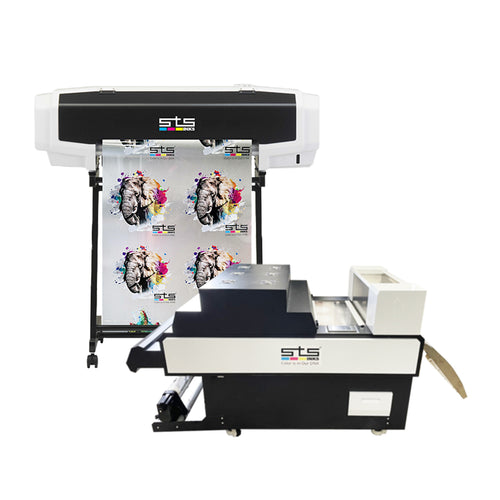Ultimate Guide to DTF printing and transfers
Direct to film (DTF) printing is one of the most progressive steps that the textile industry has taken. DTF printing has resulted in complex designs being able to be printed on fabrics we never thought could be printed on. The fact that it works not only on cotton but also on a wide variety of polyblends, makes the technology perfect. If you are looking for convenience, quality, and consistency, you need to switch to DTF printers and we are going to give you the ultimate guide on how to do that in this article.
Why You Need To Switch To DTF Printing
There are several other existing printing technologies and we cannot discount the fact that they are good but compared to DTF printers they do not come anywhere close. If you already use a different printing mechanism, here are some reasons why should switch to DTF printing.
DTF VS Print and Cut Heat Seal Vinyl
If you are using the Print and Cut Heat Seal Vinyl then you know how labor-intensive it is to end up with a final product that is not marred by excess vinyl. Even the time it takes to come up with a single piece of perfectly printed fabric is nearly an eternity. If you go with DTF, that is one thing that you won’t have to worry about. DTF printing offers an efficient printing process that does not require weeding.
DTF VS Screen Printing
Screen printing is renowned for high output quality but if you are dealing with small quantities the process can be quite wasteful. This is even worse if you are dealing with complex mufti color designs. It can be very expensive. The story is different though, with DTF printing, as the design or the quantity has a negligible effect on the per-unit cost of the final product.
DTF VS DTG
In terms of the processing system, DTG printing and DTF printing are very close. The main difference though is the limitation that comes with DTG.DTG only works on cotton garments and factoring in the time and resources required for pretreatment of fabric, the process essentially becomes cumbersome compared to using DTF.
DTF VS Sublimation
Although sublimation produces top-tier end-product quality, the fabric limitations make the mechanism a bit too complex compared to DTF. The purchase and maintenance cost of sublimation printing also gives, DTF an edge.
What To Look For When Buying a New DTF Printer
Choosing to buy a DTF printer is a no-brainer, choosing a specific DTF Printer to buy is quite complex. Here are some of the things that you should be on the lookout for when making your purchase decision.
Size: It is important to choose a DTF printer that fits your workspace. If you have a small space, you can go with a 24-inch printer. It is also important to note that the size of your DTF printer also has a bearing on the size of garments you can print on.
Software Compatibility: Design and RIP software that you have access to, should be compatible with the DTF printer you chose to purchase. This is something that you should consider and make sure of.
Power Requirements: DTF printers are electrical components, there is a need to ensure that they are compatible with your available power supply. The last thing you would want is to short circuit your printer.
G7 Certification: Your DTF printer needs to be compliant with G7 color standards. The reason for this is that all the other consumables and software are designed using the G7 color guidelines. Your printer needs to be compliant to ensure great end-product quality.
Warranty: You need a warranty for your printer. This is important as there is always a probability of a technical fault with your DTF printer as it is with all the other printers. There is a need to ensure that there is a remedy if a problem arises.
How to Heat Press Your DTF Print
Heat pressing is one of the most essential elements of the DTF printing process. If you have a curing oven, the heating process is easy. All you have to do is place your PET film and adhesive power mix in the curing oven. This is one of the easiest ways to melt the print as you can easily regulate the temperature.
If you do not have access to a curing oven, a heating press will do. Just make sure that there is no direct contact between the film and the heat press. A 4-7mm distance will do.
Once the film has been heated, the print can be transferred to the fabric. This is the integral process of the entire DTF printing process. The process uses a heat press to transfer the print on the film to the fabric. The process is 15-20 seconds long and is done at an extremely high temperature of up to 170 degrees Celsius.
How To Make Your DTF Prints
Getting the final print is easy and creating the print is easy as well. The first thing is choosing software that you are comfortable with. Make sure that you choose the correct dimensions during design. This helps to avoid image distortion, during design transfer.
In terms of fabric material, DTF gives you a lot of freedom. Non-treated cotton, silk, polyester, denim, nylon, leather, 50/50 blend are all compatible with DTF printing. One thing that is important though is to ensure that whatever material, you choose can withstand the 170 degrees delicious threshold during curing.
DTF ink and powders should also be compatible with the printer you are using. Consumables have a huge bearing on the final product quality.
Are Your DTF Inks and DTF Powders Safe?
DTF printing uses a combination of ink and powder to come up with a perfectly printed garment. The question, you might be asking is whether the combination is safe for your fabric or most importantly yourself during the operation.
The simple answer is, yes STS DTF powders and STS DTF inks are safe for both you and your fabric. STS DTF inks are not toxic, the same applies to STS DTF powders. Although DTF inks might be difficult to wash off, using water only adding detergent will help to easily remove the ink.
If you are working with DTF inks and DTF powders, we recommend you avoid them getting into contact with your skin as they may be difficult to wash off. Wear high boots, long sleeve garments, and gloves.
How To Wash Your DTF Prints
Once your DTF print is transferred to the garment, there are some precautions that you have to take to ensure that you do not end up spoiling the printed garment.
The DTF print is sensitive to harsh conditions. That is high temperatures and high rpm washing cycles. This means that care needs to be taken during washing. Makes sure that before you wash your garments, they are turned inside out.
Set the washing machine RPM are set to medium, that is 600-800 RPM. It is also important to ensure that the washing temperature is set to between 30-60 degrees Celsius. It is also important to avoid wash periods longer than 1hour.
In terms of detergents, avoid powdered detergents at all costs. The solid granules result in print stress and may result in the print eventually getting damaged. Fabric softener is a straight no. Due to the softener-print interaction; it can be difficult to eliminate bad odor and even dirt. Fabric softeners can also result in accelerated wear of the print. If you want to avoid your DTF print peeling off do not use fabric softener.
In terms of drying, air drying is the best option. Tumble drying is not recommended. During sun drying ensure that the garment remains turned inside out.
How to Care For Your STS Mutoh VJ-628D DTF Printer
DTF printers are amazing and if you want to maintain a high level of performance, you have to take care of your printer. Taking care of your STS Mutoh VJ-628D DTF printer is a service to yourself as it saves you a lot of money. Here are some of the main points you need to focus on to ensure you prolong the service life of your STS Mutoh VJ-628D DTF printer.
Want To Find Out More?
We have gone in-depth on everything there is to know about DTF printing and if you are planning to get a DTF printer, STS Mutoh should be your first port of call. There is only one.



